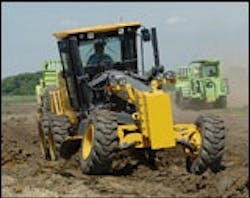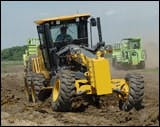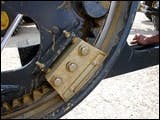Motor-Grader Technology Hits High Gear
- Champion
- John Deere
- Case
- PSI
- Terex
- Huber
- Caterpillar
- LeeBoy
- Noram
- Flannegan Western
- Volvo
- Komatsu
- New Holland
- Basic Equipment
- Changlin
- Intensus
- Power-train refinement
- More control, easy service
- Motor-Grader Specifications
- Average List Prices and Hourly Rates
Although Caterpillar did intensive preparatory homework, we'd still bet that you could have almost heard the company take a corporate deep breath just before deciding to design its new M-Series motor graders without conventional controls, that is, less the two banks of control levers that flank the steering wheel — and, yes, less even the steering wheel. Replacing all those familiar controls are but two multi-function joysticks. Caterpillar's big news, however, is only the most recent in a string of major announcements regarding motor-grader refinement and new-model introductions. Motor-grader manufacturers have been busy.
In April, for example, Volvo officially introduced its seven new G900-Series machines, which reflect an absolutely new design, compared to their B-Series predecessors, and feature an industry first — an optional 11-speed transmission. And earlier this year, Terex added four torque-converter-drive motor graders to its product mix. Then, going back little more than a year, Deere replaced its C-Series range with significantly redesigned D-Series machines, including two new models larger than any the company has yet offered.
Preceding all this activity was Komatsu's introduction of its Laterra Series, which features machines that have both a torque-converter-drive mode and a direct-drive mode. Other significant motor-grader news in the past 24 months or so has included LeeBoy's introduction of its largest machine ever, the 25,000-pound 785, Champion's redesign of its C80C and C86C, plus Huber's refinement of its Maintainer into the new D-Series M-850. By our reckoning, not counting Caterpillar's H-Series models (some of which will remain available until mid-2007), motor-grader buyers now have more than 60 model choices in today's market.
This resurgence in motor-grader design refinement may have received impetus from the market turnaround that took hold in 2004. After a down cycle that lasted for the best part of five years, sales numbers began to climb that year — and are now projected to grow moderately for the next several years from the current annual global-market total of 7,000 to 8,000 units. North America remains the largest market for motor graders, consuming about half the annual total.
When preparing the specification chart for this report, we noted with interest the variation in drive-train design reflected in today's motor graders, namely, the use of hydrostatic transmissions, direct-drive powershift transmissions, and powershift transmissions with torque converters.
What the specifications show is that machines on the small end of the weight scale are generally hydrostatically driven, the largest hydrostatics being the PSI MG618 and MG622 models, which weigh in at about 18,500 and 23,000 pounds, respectively. But not all smaller units are hydrostatic. The Noram 65E Turbo, for instance, at 16,800 pounds and 110 horsepower, uses a powershift transmission with a torque converter.
Although hydrostatic drive may be the most cost-effective design for smaller units, manufacturers using the technology say that the drive system provides exceptional low-speed performance and control, compared with controlling a powershift transmission with an inching pedal and brake.
According to the chart, 15 models use hydrostatic drive, 31 use a direct-drive powershift, and another 15 use a powershift in conjunction with a torque converter. According to Komatsu, its Laterra Series models, in the four lower gears, provide either torque-converter-drive or direct-drive (when the converter is locked). This system, says the company, takes into account that one or the other of the drive modes may yield better performance in a given situation.
Direct-drive systems, however, are becoming friendlier, as evidenced by the new Deere, Volvo and Caterpillar transmission systems that allow directional changes without using the inching pedal. Many direct-drive powershift systems also incorporate an "auto-shift" feature, which relieves the operator of tiresome shifting in operations that require going up and down through the gears. And Volvo, with its optional 11-speed powershift, makes the point that smaller steps between gears allows the operator to more easily find the most efficient torque/speed combination for a given situation.
Front-wheel-assist systems also are becoming friendlier, in terms of allowing the operator more control. Deere's D-Series system, for instance, allows the operator (as do other systems) to dial in how aggressively the front wheels pull, and it also allows the operator to adjust the inching-pedal mode to either engage the front wheels simultaneously with the tandem, or to delay engagement until the tandem has taken hold. The Cat M-Series models and the Volvo G900-Series models that are equipped with all-wheel drive feature a front-wheel-drive-only mode for use in situations requiring precise control.
And to complement drive-train refinement, the variable-horsepower feature, available with engines in certain motor-grader models, also is being refined. According to manufacturers offering the variable-horsepower feature, its purpose is to provide custom power and torque curves for certain gears or gear groups in order to more effectively match machine performance to the application. For example, Volvo's new system provides three power ranges and uses a speed/power switch to limit maximum rpm in the two lower ranges. Caterpillar's new variable-horsepower system, standard on the M-Series, delivers additional horsepower in 5-hp increments as transmission gear selection increases.
Generalizing about the implement hydraulic systems on today's motor graders, we'd say that more systems are being designed to provide enhanced efficiency, better multi-function operation and reduced hydraulic effort at the control levers — the latter benefit also complemented by levers that may be closer together and have shorter throws than previous designs. To gain these advantages, some larger machines are now using pressure-compensated/load-sensing systems that incorporate variable-displacement pumps.
Although these variable-flow systems are extremely efficient, there's always a danger in touting their advantages, lest simpler systems be perceived as inferior. That's not the intent here (nor the truth), because constant-flow systems also have been refined for greater efficiency and controllability, and in some instances are the most cost-effective choicefor smaller machines.
Another focus of today's motor-grader design is the geometry of the moldboard and draft frame. By adjusting the angles at the moldboard's cutting edge and at its top radius, for example, material entering the blade can be made to start rolling sooner and to encounter less resistance as it moves up and across the blade. Less resistance means that the grader moves more smoothly through the cut and uses less horsepower (and less fuel) in the process. Among draft-frame changes, some manufacturers have adjusted this component upward, thus increasing the free space between the top of the moldboard and the bottom of the circle to minimize plugging in sticky material.
Another basic observation about today's graders is their enhanced serviceability. This includes everything from advanced electronic diagnostic systems, to centralized lubrication banks, to ground level, one-side access to routine service points.
But of special note are new systems for maintaining the adjustment of the draft frame, circle and moldboard. In some instances, for example, moldboard shims have been eliminated, and in other systems, easy access to circle wear inserts allows changing these components in a couple of hours. As more motor graders are fitted with automated grade-control systems, of course, keeping the moldboard and its related support systems in adjustment has become critical.
And one final thought that brings us full circle to the use of joystick controllers. Reliable market intelligence tells us that at least one other motor-grader manufacturer has prototype machines running with joysticks. But, all you seasoned operators can relax. Motor graders are still best operated by experienced hands, whether those hands are gripping joysticks or conventional controls.
| Web Resources | ||
www.changlincanade.com www.newhollandconstruction.com www.volvoce.com | ||



